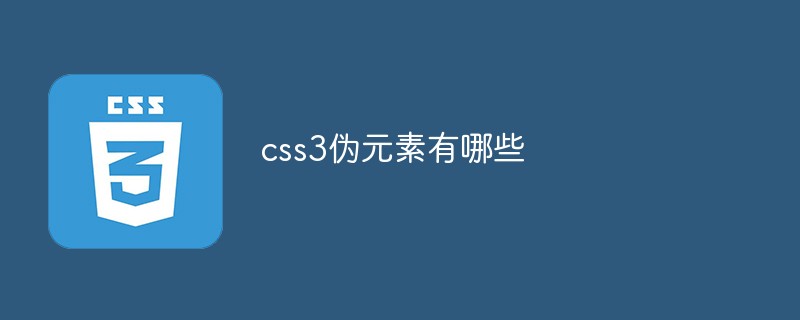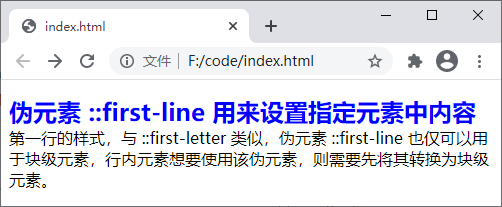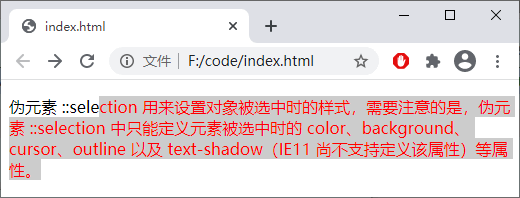css3伪元素有哪些
css3伪元素有:1、“::after”,可在指定元素的后面插入一些内容;2、“::before”;3、“::first-letter”;4、“::first-line”;5、“::selection”;6、“::placeholder”。

本教程操作环境:windows7系统、CSS3&&HTML5版、Dell G3电脑。
伪元素是一个附加在选择器末尾的关键词,通过伪元素您不需要借助元素的 ID 或 class 属性就可以对被选择元素的特定部分定义样式。例如通过伪元素您可以设置段落中第一个字母的样式,或者在元素之前、之后插入一些内容等等。
在 CSS1 和 CSS2 中,伪元素的使用与伪类相同,都是使一个冒号:与选择器相连。但在 CSS3 中,将伪元素单冒号的使用方法改为了使用双冒号::,以此来区分伪类和伪元素。因此,建议在使用伪元素时使用双冒号而不是单冒号。
selector::pseudo-element {
property: value;
}其中,selector 为选择器,pseudo-element 为伪元素的名称,property 为 CSS 中的属性,value 为属性对应的值。
CSS 中提供了一系列的伪元素,如下表所示:
| 伪元素 | 例子 | 例子描述 |
|---|---|---|
| ::after | p::after | 在每个 元素之后插入内容 |
| ::before | p::before | 在每个 元素之前插入内容 |
| ::first-letter | p::first-letter | 匹配每个 元素中内容的首字母 |
| ::first-line | p::first-line | 匹配每个 元素中内容的首行 |
| ::selection | p::selection | 匹配用户选择的元素部分 |
| ::placeholder | input::placeholder | 匹配每个表单输入框(例如 )的 placeholder 属性 |
1. ::after
伪元素 ::after 能够在指定元素的后面插入一些内容,在 ::after 中需要使用 content 属性来定义要追加的内容,而且在 ::after 中必须定义 content 属性才会生效(没有需要插入的内容时可以将 content 属性的值定义为空"")。
下面通过一个示例来演示伪元素 ::after 的使用:
<!DOCTYPE html>
<html>
<head>
<style>
p.one::after {
content:"";
display: inline-block;
width: 50px;
height: 10px;
background: blue;
}
p.two::after {
content:"要插入的内容";
color: red;
font-size: 6px;
}
p.three::after {
content: url('./smiley.gif');
position: relative;
top: 8px;
}
</style>
</head>
<body>
<p class="one">伪元素 ::after</p>
<p class="two">伪元素 ::after</p>
<p class="three">伪元素 ::after</p>
</body>
</html>运行结果如下图所示:

2. ::before
伪元素 ::before 能够在指定元素的前面插入一些内容。与 ::after 相似,::before 中也需要使用 content 属性来定义要追加的内容,而且在 ::before 中必须定义 content 属性才会生效(没有需要插入的内容时可以将 content 属性的值定义为空"")。
下面通过一个示例来演示伪元素 ::before 的使用:
<!DOCTYPE html>
<html>
<head>
<style>
p.one::before {
content:"";
display: inline-block;
width: 50px;
height: 10px;
background: blue;
}
p.two::before {
content:"要插入的内容";
color: red;
font-size: 6px;
}
p.three::before {
content: url('./smiley.gif');
position: relative;
top: 8px;
}
</style>
</head>
<body>
<p class="one">伪元素 ::before</p>
<p class="two">伪元素 ::before</p>
<p class="three">伪元素 ::before</p>
</body>
</html>运行结果如下图所示:

3. ::first-letter
伪元素 ::first-letter 用来设置指定元素中内容第一个字符的样式,通常用来配合 font-size 和 float 属性制作首字下沉效果。需要注意的是,伪元素 ::first-letter 仅可以用于块级元素,行内元素想要使用该伪元素,则需要先将其转换为块级元素。
下面通过示例来演示伪元素 ::first-letter 的使用:
<!DOCTYPE html>
<html>
<head>
<style>
p::first-letter{
font-size: 2em;
color: blue;
}
</style>
</head>
<body>
<p>伪元素 ::first-letter</p>
</body>
</html>运行结果如下图所示:

4. ::first-line
伪元素 ::first-line 用来设置指定元素中内容第一行的样式,与 ::first-letter 类似,伪元素 ::first-line 也仅可以用于块级元素,行内元素想要使用该伪元素,则需要先将其转换为块级元素。
下面通过示例来演示伪元素 ::first-line 的使用:
<!DOCTYPE html>
<html>
<head>
<style>
p::first-line{
font-size: 1.5em;
color: blue;
font-weight: bold;
}
</style>
</head>
<body>
<p>伪元素 ::first-line 用来设置指定元素中内容第一行的样式,与 ::first-letter 类似,伪元素 ::first-line 也仅可以用于块级元素,行内元素想要使用该伪元素,则需要先将其转换为块级元素。</p>
</body>
</html>运行结果如下图所示:

5. ::selection
伪元素 ::selection 用来设置对象被选中时的样式,需要注意的是,伪元素 ::selection 中只能定义元素被选中时的 color、background、cursor、outline 以及 text-shadow(IE11 尚不支持定义该属性)等属性。
下面通过示例来演示伪元素 ::selection 的使用:
<!DOCTYPE html>
<html>
<head>
<style>
p::selection{
color: red;
background-color: #CCC;
}
</style>
</head>
<body>
<p>伪元素 ::selection 用来设置对象被选中时的样式,需要注意的是,伪元素 ::selection 中只能定义元素被选中时的 color、background、cursor、outline 以及 text-shadow(IE11 尚不支持定义该属性)等属性。 </p>
</body>
</html>运行结果如下图所示:

6. ::placeholder
伪元素 ::placeholder 用来设置表单元素(、


